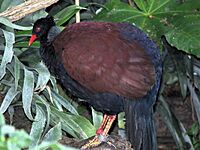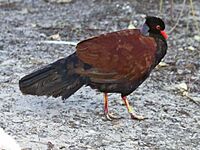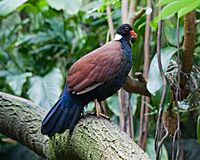Pheasant pigeon facts for kids
Quick facts for kids Pheasant pigeon |
|
|---|---|
 |
|
| White-naped pheasant pigeon | |
| Scientific classification |
The pheasant pigeon (Otidiphaps nobilis) is a cool bird. It looks a lot like a pheasant but is actually a type of large pigeon. It's the only species in its special group called Otidiphaps. You can find these pigeons living in the thick rainforests of New Guinea and some islands nearby. They usually live in hilly or lower mountain areas, but sometimes they are found in flat lowlands too.
Contents
About the Pheasant Pigeon's Name
The pheasant pigeon's scientific name, Otidiphaps, connects it to a bird family called bustards (Otidae). This is because it shares some features with them. Its common name, "pheasant pigeon," comes from how it acts. It lives on the forest floor, much like a pheasant from Southeast Asia.
Different Kinds of Pheasant Pigeons
There are four main types, or subspecies, of pheasant pigeons. They mostly look different because of a small feathery crest or the color of their neck (called the nape).
- White-naped pheasant pigeon (O. n. aruensis): This type lives on the Aru Islands. It is considered vulnerable, meaning it needs protection.
- Green-naped pheasant pigeon (O. n. nobilis): You can find this one in western New Guinea and on Batanta and Waigeo Islands. It is the most common type.
- Grey-naped pheasant pigeon (O. n. cervicalis): This pigeon lives in eastern and southeastern New Guinea. It is also a common type.
- Black-naped pheasant pigeon (O. n. insularis): This rare type lives on Fergusson Island. It is critically endangered, meaning it is very close to disappearing.
Some scientists think these four types are actually four different species. This is how the IUCN (a group that tracks endangered species) sees them.
What Does the Pheasant Pigeon Look Like?
The pheasant pigeon really does look like a pheasant! It has a tail that is flat on the sides and round wings. Their heads, bellies, backs, and lower backs are shiny black. Their short, round wings are brown. The color of their neck (nape) can be white, green, grey, or black, depending on the type.
There are no birds like pheasants in New Guinea. So, the pheasant pigeon has taken on the role of a small pheasant or partridge there. Larger birds like the crowned pigeons act more like big pheasants or turkeys.
Life and Habits
The pheasant pigeon is a very shy bird. It mostly eats seeds and fruits that have fallen to the ground. It builds its nest on the ground, hidden under trees and bushes. The female lays one egg, and both parents take turns keeping it warm for about four weeks.
Both parents also care for the young bird. They feed their chick a special liquid called "crop milk." This is a common way for most pigeons to feed their babies.
Sounds and Habitat
Pheasant pigeons make different sounds. They have a sound like a drill, a typical pigeon cooing sound, and a loud "wu-huwoooooa" call. This call goes up and down in sound before fading away.
These birds live in rainforests, especially in the Aru Islands. They avoid places where people live. Because of this, most of what we know about their behavior comes from watching them in zoos.
Protecting the Pheasant Pigeon
Scientists believe the number of pheasant pigeons is slowly going down. This is mainly because their forest homes are being cut down for wood (logging) and for farms. Since this bird needs old, untouched forests to live, and it's the only one of its kind, it's very important to study and protect it.
Not all types of pheasant pigeons are in danger. The green-naped and grey-naped types are doing okay. However, the black-naped pheasant pigeon is critically endangered, and the white-naped pheasant pigeon is vulnerable.
For a long time, the black-naped pheasant pigeon was only known from one bird collected in 1882. People thought it was extinct for 140 years! But in late 2022, researchers found it again using a special camera trap on Fergusson Island. This was exciting news for conservation!





